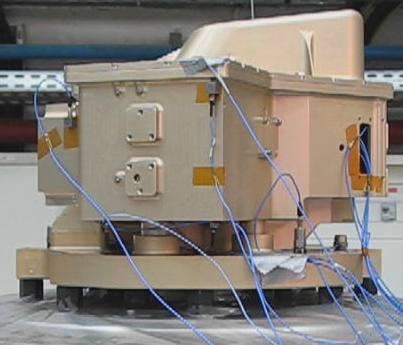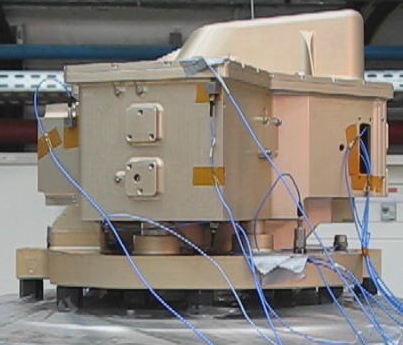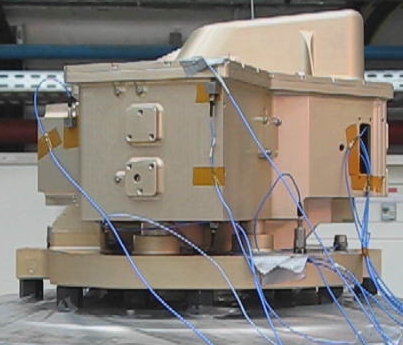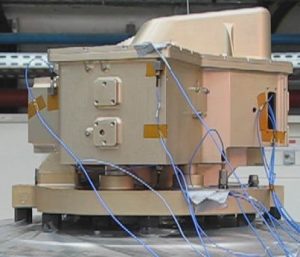The MIRIM-OB instrument for JWST passed the test
The realization of MIRIM-OB, the optical bench of MIRI (Mid Infra Red Imager), one of the four instruments which will equip the forthcoming space telescope JWST has just completed an essential step with the demonstration that it fulfills the various and rigorous constraints imposed by its use in space. The exam, called the “Qualification Review”, which included vibration-proof, temperature holding and survival against the various radiation hazards appropriate to the environment in space, was carried out in conjunction with specialists from the contract management agencies. This process being successfully completed it now allows the construction of the instrument which will be attached to the focal plane of JWST, whose launch date is expected for 2013.

A serie of tests
The “Qualification Review” of a space instrument is the process by which the group of configuration items comprising the complete system is verified to have met the specific performance requirements for launch and operation in space. In other words the review must verify that the instrument will cope with the general working constraints as well as with those specifically space related.

The working constraints arise mainly from the fact that the optimal temperature at which infrared detectors must be operated is about 7° Kelvin (-266° Celsius). Thus, it had to be demonstrated that MIRIM-OB could reach this temperature in view of the constraints imposed by the cooling system aboard the satellite, and that it would work at such a low temperature. It also had to be verified that the instrument would survive the various thermal cycles that it will endure during its lifetime on Earth and in space, from the temperature required for molecular decontamination (80° Celsius) to the one held during operations.
The space-related constraints are numerous and of various types. The instrument will experience mechanical and acoustical vibrations, which can be very high during the launch. Operations in vacuum conditions impose also specific constraints, in particular related to the thermal conductivity, the outgassing during launch, as well as to the use of materials. It must be verified also that the instrument is designed for preventing any contamination (from either particles or molecules) that could degrade its performance or even possibly make it fail. Systems in space are exposed to high levels of radiation, whose effects accumulate in the course of time and which can be also locally produced by random events. Finally, since a satellite consists of an isolated and closed electric environment, hazards of locally generated electromagnetic disturbances are significant and must be avoided.


A successful exam
The verification that the instrument meets all these requirements is made through various paths: theoretical simulations, possible legacy of previous space missions which could have used identical or similar systems, processes or materials, and laboratory tests carried out with intermediate models. The materials, components and processes that will be used, must be verified separately.
Preparing the review consists in assembling all aspects (documentation, tests results and analyses…) that will make up the proofs for the qualification. The review was held in the premises of the Service d’Astrophysique (SAp) of the CEA-IRFU at Saclay in February 2008, and was declared “successfully completed” by the Review Committee which includes international experts from the MIRI [1] Consortium, the European Space Agency, (ESA), and the National Aeronautics and Space Administration (NASA).
The review giving the OK for the fabrication of the actual flight model was held on the same day and was similarly successful. The MIRIM-OB flight Model has now undergone its fabrication phase. Its delivery to the Rutherford Appleton Laboratory (RAL) for final integration within MIRI is expected for mid-2009, once the cryogenic tests which will soon begin are completed.
Contact : Jean-Louis Auguères
|
|
The cryostat in the Mirim imager |
More informations on JWST-MIRI
|
|
The JWST/MIRI site of the Astrophysics department |
Notes :
The MIRI consortium includes the laboratories from the 10 European countries involved in the project (Great Britain, France, Germany, the Netherlands, Belgium, Sweden, Denmark, Switzerland, Spain and Ireland) and ESA.Under contract with ESA, CNES is in charge of the French participation in the MIRIM instrument, in partnership with the CEA/IRFU – Service d’Astrophysique which leads also the scientific and technical related activities. The French participation includes also the Laboratoire d’Etudes Spatiales et d’Instrumentation en Astrophysique (LESIA / Observatoire de Paris), the Institut d’Astrophysique Spatiale (IAS / CNRS & Université de Paris-Sud) and the Laboratoire d’Astrophysique de Marseille (LAM, Observatoire astronomique de Marseille-Provence/CNRS).
Rédaction: J.L. Auguères, P. Bouchet



